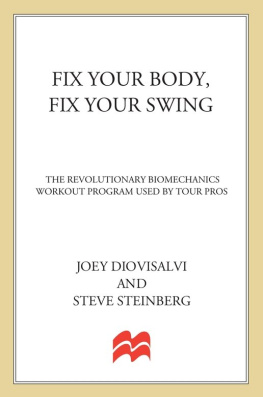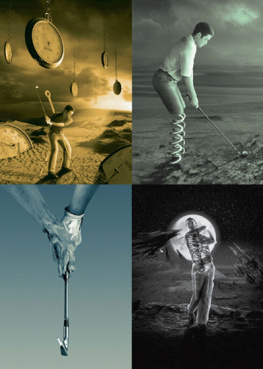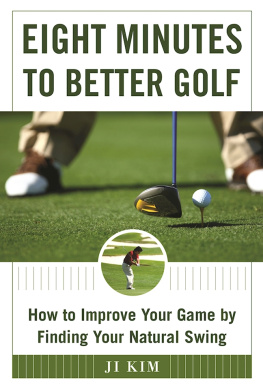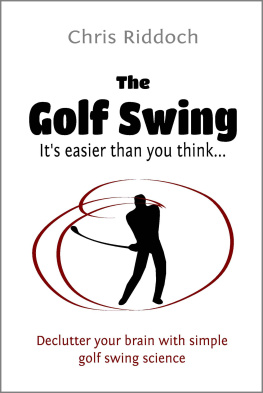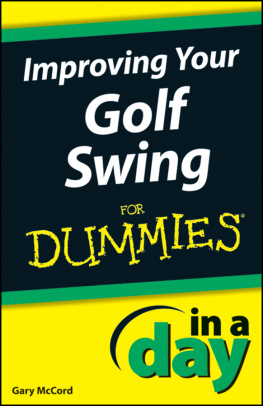Thanks to Steve Cohen, Marc Resnick, and everyone at St. Martins Press for believing and trusting in what this book is about. To Greg Hopkins and Cleve- land Golf for having the vision to see the impact that biomechanics would have on the sport of golf. To my very good friend Vijay Singh for inspiring me to truly learn to understand golf at such a deep level. This book would not ex- ist had it not been for Vijays dedication to the game. To Jason Dufner, Jason Gore, Ryuji Imada, Pat Perez, Travis Perkins, Tom Pernice Jr., John Rollins, Charlie Wi, and Tim Wilkinson. To Sophie Gustafson, Zach Johnson, Davis Love III, Jim Nantz, and Ian Poulter. To Todd Jones and everyone at the PGA Tour Academy at TPC Sawgrass for allowing me to teach at such an elite level. And to the PGA Tour for being such an instrumental part of my life and career over the last ten years.
Joey Diovisalvi, June 2009
Thanks to Joey Diovisalvi for opening up his home to me, letting me help him deliver his message, andmost importantlybecoming a good friend. To his players for being so accessible and candid. To the people at St. Martins Press for being so helpful and easy to work with. And thanks to these folks for contributions large and small: Andre, Cherie, Don, Erin, Justin, Michele, Patrick, and Sabunim.
Steve Steinberg, June 2009
Who Is Joey D.?
or Why Are You Reading This Book?
J oey D., Vijay Singh said with a giant smile on his face. You sounded taller over the phone.
The first time I met Vijay Singh, he insulted me. I instantly liked him.
This was back in 2001. Hed heard some good things about me and thought maybe something about this unorthodox golf coach with some unorthodox training methods could help him take his game to the next level. Vijay and I worked together for a few months, and in March 2002 he notched his first tour victory in almost two years by winning the Shell Houston Open by a comfortable six strokes.
He invited me to fly back to Ponte Vedra, Florida, with him on his plane.
What would it take to get you to work with me exclusively? he asked me. Before I could even start to consider the offer, he added, I know I can be the best player in the world.
In 2002, everyone just assumed that Tiger Woods was invincible and would be number one in the world for as long as the sport of golf interested him. Vijay Singh was a PGA Tour Rookie of the Year in 1993, but had managed just a single tour win since 2000. Here he was, though, telling me that he thought he could be number one. Most people would have laughed at his prediction, but I knew how hard a worker he was. In the time I had been with him, hed just about kill himself whenever we worked out. I respected his work ethic immensely, but I also knew that trying to overtake Tiger would be going up against some stiff odds. I knew something about facing insurmountable odds, though.
I sold my training facility in south Florida and moved north to Ponte Vedra.
In September 2004, Vijay outshot Tiger Woods and Adam Scott by three strokes to win the Deutsche Bank Championship in Norton, Massachusetts. As a result, he leapfrogged over Tiger and into the number one spot in the world. Thanks to hard work and a team of dedicated and knowledgeable professionals, Vijay had made good on his prediction. In April 2005, when he was elected into the World Golf Hall of Fame, Vijay thanked several people in his acceptance speech. I was one of them. I sometimes wonder what it was that made me uproot my life to go work with him, and I always come back to what he said to me on that flight from Texas: I know I can be the best player in the world.
Something about his confidence and determination reminded me of someone.
As a kid, I would never accept anything but 100 percent of myself. I played football in junior leagues and developmental leagues, and I recognized early on that I was stronger and faster than the other kids. Physically, I was pretty lucky in my genetics. But mentally, I just approached the game differently from my friends. The way I thought about things was completely different from anybody elses. Id see things that no one else saw. I recognized I was a leader because I had no fear of anything at all. That could have been a good thing or a bad thing, but it made me relentless in just about anything I did.
I never wanted anyone to drive me to football practice, for example. I wanted to ride my bike to practice because, I used to think, if I rode my bike, I would already be ahead of the curve when I got there. And if we didnt win a game, I would come completely unglued. Everybody would leave to do whatever they did after a game, and I would just stay there doing drills and running for hours. I grew up in Manalapan, New Jerseya typical suburb in Monmouth County. In the late summer, I knew that football season was right around the corner, and I would run up and down the hills. Itd be light out when I started, and eventually the sun would go down and it would be dark and Id still be running. Itd be nine at night and Id still be out there. I used to tell myself, I need to be faster. I need to be in better shape than anybody else when I get to the first day of practice.
When the season started, I was always in the best shape I could possibly be in. Couple this with my natural skills, and I was a monster on the field. Theyd put me on the bench after the first half because I was destroying people. Opposing coaches constantly questioned my age, saying I had to have been much older than I said I was.
Im not sure where this extreme work ethic came from. I come from an average middle-class family. Everybody worked and everyone had this dream and vision to better himself. You were taught from the beginning that hard work was the key to successon the field, in the classroom, everywhere. My dad was demanding about grades. If I wasnt on the honor roll, I couldnt play any sports. It drove me to understand the importance of education. And since I was so driven about getting in the best shape I could be in, it was natural for me to start learning as much as I could about how the body worked.
From a young age, I started studying what I could do to make myself a better athlete. I knew it was more than just pure strengthmore than just how much I could bench-press or how much I could squat. Being an athlete was about knowing how to use that strength in motion. The strongest guy on the field is just the strongest guy on the field unless he knows how to use that strength in the particular sport that hes playing. By then, I had branched out from just playing football. I had started wrestling and began studying martial arts. I was continually amazed at how these lighter-weight-class wrestlers and my martial arts instructorsat maybe 130 poundscould do these incredible things with their bodies. They generated the same amount of strength and power and explosiveness as much bigger guys. I started to become obsessed with figuring out where this ability came from. How could these small individuals have this power and transfer it through movement and have such amazing results? In my head, I began to think about how these movements and movement patterns could be applied to other sports with similar results. Thats when I started to really understand movement strength.

